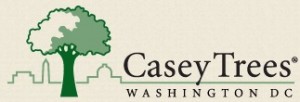Working for Casey Trees for six months has not only allowed me to get a glimpse into the non-profit realm, but has also given me the chance to understand the many ways that these types of organizations collaborate in order to find the most effective measures of reaching their mission. Casey Trees works to restore, enhance, and protect the urban tree canopy in Washington, D.C. through planting, research, education, social events, and overall community engagement. They, along with hundreds of volunteers, plant trees all over the District and reach out to community members to advocate for trees in their area.

While Casey Trees has a talented and driven group of individuals working together to get trees in the ground, they also have a large support group outside of D.C. to help them along, and vice versa. The Urban Ecology Collaborative (UEC) is one shining example of this. The UEC has members in cities along the east coast from Boston to D.C. that get together monthly via webinar to share progress and ideas for improvement.

A busy intern is a happy intern
I was fortunate enough to be a part of the annual UEC meeting in Newark, New Jersey. We “camped” outside in the beautiful gardens of the Greater Newark Conservancy at night, and met and discussed current successes and challenges in the urban forestry field during the day. We heard excellent stories of parks being saved and became aware of the enthusiasm coming from the youth of the area to beautify Newark. Not only was this meeting valuable for idea-sharing and problem-solving, but it also allowed us in the field to see the product of some of our hard work. Personally, I was able to learn about a few organizations that I hadn’t heard of before and get a clearer picture of how different the challenges are for each city that was there.
Another great example of collaboration across cities is the Urban Forestry Monitoring Protocol study. Six cities participated in a citizen science project that is meant to measure the accuracy of volunteer data collection. Groups of novices, intermediates, and experts went into the field and measured and analyzed 150 trees in their corresponding city. The data for each skill group was compared against each other to see the accuracy, and the information will be used to improve the overall collection of urban forestry data.
From field work to data cleaning and from data cleaning to research questions
When I first joined Casey Trees, I was working in the field to gather survival data for 51% of all of their trees planted from 2003 to 2011. I was able to learn the science of trees while biking around D.C. and measuring almost 5,000 trees with three other great interns and overall environmental advocates. When we were finished gathering all of our data, I stayed on with Casey Trees to put the skills I learned in my first year at Bard Center for Environmental Policy to work.
The Technical Services and Research department delved into the data to get it cleaned up and organized and to see what we were really working with. What information do we have? What can we do with the data? How can it be presented? What questions can we answer with it?
In completion of my master’s degree with Bard CEP, I will be working to determine influential mortality factors on urban trees in Washington, D.C. and portraying the reasons why planting trees, growing urban canopies, and expanding overall green space are so important. I hope that this research will help Casey Trees and other urban forestry organizations across the country to grow and protect their tree canopies.

With all of the wonderful, enthusiastic, passionate people in the non-profit (and government, and for-profit) fields, the future for trees and the environment is looking bright.
